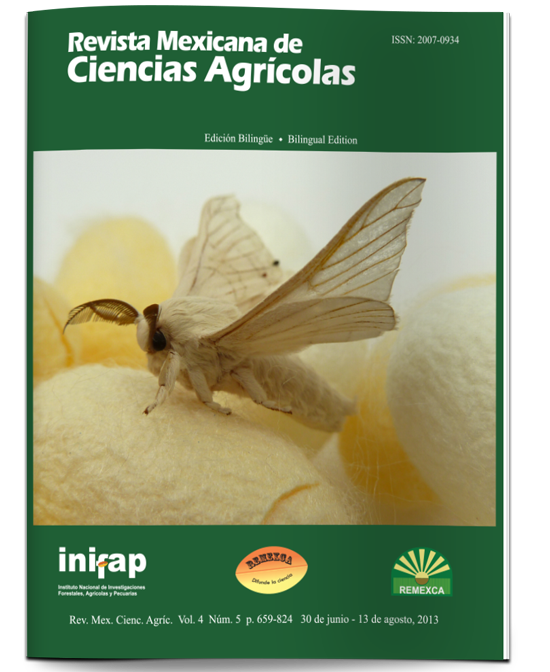Potencial forrajero de cuatro especies leguminosas en el ciclo de verano en la Comarca Lagunera
DOI:
https://doi.org/10.29312/remexca.v4i5.1166Palabras clave:
composición química del forraje, distribución de materia seca, rendimientos de materia seca y nutrientesResumen
Una alternativa para mejorar la calidad de las dietas para el ganado lechero, es mediante el uso de leguminosas anuales. El objetivo del presente estudio fue comparar la composición nutricional y los rendimientos potenciales de materia seca (MS) y nutrientes de cuatro especies leguminosas anuales durante el periodo disponible en el ciclo de verano en la Comarca Lagunera. El experimento se estableció el cinco y ocho de julio de 2005 y 2006, respectivamente, en el Campo Experimental La Laguna del INIFAP localizado en Matamoros, Coahuila, México. Se evaluaron dos genotipos de chícharo de vaca (Vigna unguiculata L.), uno de frijol gandul (Cajanus cajan L.), cuatro de soya (Glycine max L.) y uno de frijol dolichos (Lablab purpureus L.). Se utilizó un diseño experimental de bloques completos al azar con cuatro repeticiones. Se determinó el rendimiento de MS, distribución de MS en la parte aérea y composición química del forraje. Los rendimientos de soya (7 757-9 280 kg ha-1) fueron superiores (p≤ 0.05) a los de chícharo de vaca, frijol gandúl y frijol dolichos (2 200-6 132 kg ha-1). Los mejores resultados se obtuvieron en soya ‘Hutchinson’ (p≤ 0.05), debido a sus altos rendimientos de MS, energía neta para lactancia (ENl) y proteína cruda (PC) por hectárea, además de su buena composición nutricional, medida en términos de contenidos de PC (228-242 g kg-1), ENl (1.48-1.58 Mcal kg-1 MS) y fibra detergente neutro (318-335 g kg-1). Su baja asignación de MS hacia el tallo y su precocidad propiciaron una mayor proporción de vainas en el forraje (p≤ 0.05) incrementando la composición nutricional durante el ciclo de verano.
Descargas
Descargas
Publicado
Cómo citar
Número
Sección
Licencia
Los autores(as) que publiquen en Revista Mexicana de Ciencias Agrícolas aceptan las siguientes condiciones:
De acuerdo con la legislación de derechos de autor, Revista Mexicana de Ciencias Agrícolas reconoce y respeta el derecho moral de los autores(as), así como la titularidad del derecho patrimonial, el cual será cedido a la revista para su difusión en acceso abierto.
Los autores(as) deben de pagar una cuota por recepción de artículos antes de pasar por dictamen editorial. En caso de que la colaboración sea aceptada, el autor debe de parar la traducción de su texto al inglés.
Todos los textos publicados por Revista Mexicana de Ciencias Agrícolas -sin excepción- se distribuyen amparados bajo la licencia Creative Commons 4.0 atribución-no comercial (CC BY-NC 4.0 internacional), que permite a terceros utilizar lo publicado siempre que mencionen la autoría del trabajo y a la primera publicación en esta revista.
Los autores/as pueden realizar otros acuerdos contractuales independientes y adicionales para la distribución no exclusiva de la versión del artículo publicado en Revista Mexicana de Ciencias Agrícolas (por ejemplo incluirlo en un repositorio institucional o darlo a conocer en otros medios en papel o electrónicos) siempre que indique clara y explícitamente que el trabajo se publicó por primera vez en Revista Mexicana de Ciencias Agrícolas.
Para todo lo anterior, los autores(as) deben remitir el formato de carta-cesión de la propiedad de los derechos de la primera publicación debidamente requisitado y firmado por los autores(as). Este formato debe ser remitido en archivo PDF al correo: revista_atm@yahoo.com.mx; revistaagricola@inifap.gob.mx.
Esta obra está bajo una licencia de Creative Commons Reconocimiento-No Comercial 4.0 Internacional.



